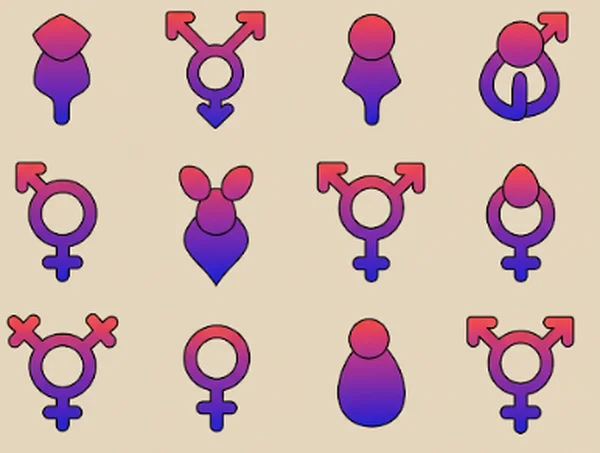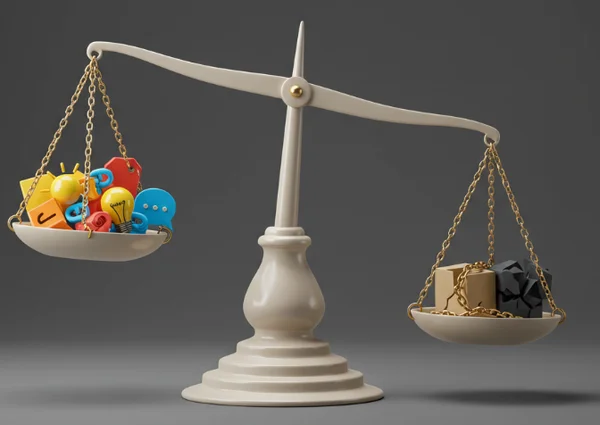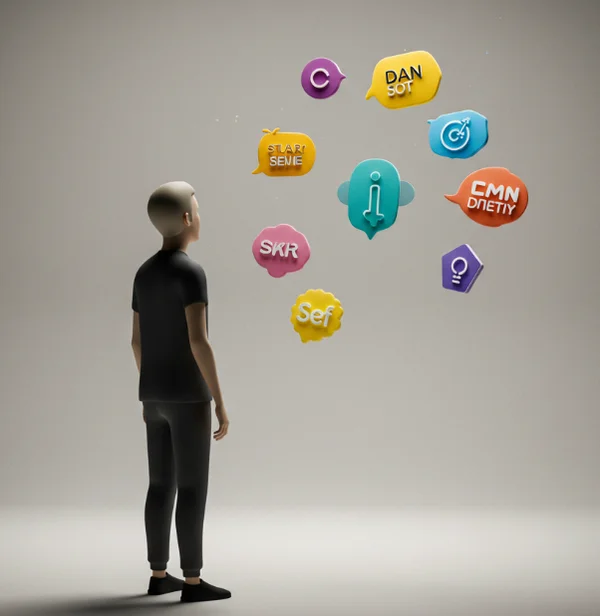Encontrando o Que te Serve (ou Não)
Navegar pelo mundo dos rótulos de sexualidade pode parecer como aprender uma nova língua. Gay, lésbica, bissexual, pansexual, assexual, queer... o que significam os rótulos LGBTQ, e mais importante, preciso de um rótulo de sexualidade para mim? Este artigo visa fornecer alguma clareza, oferecendo rótulos lgbtq explicados de forma simples, e explorando a jornada pessoal de encontrar o que, se algo, te serve. Sua exploração da identidade é única, e entender os rótulos é apenas uma parte disso.
O Que São Rótulos de Sexualidade e Por Que Eles Existem?
Então, o que exatamente são rótulos de sexualidade? Essencialmente, são palavras ou termos que as pessoas usam para descrever seus padrões de atração romântica e/ou sexual. Eles existem por uma variedade de razões, tanto pessoais quanto sociais, muitas vezes ajudando os indivíduos em sua exploração da identidade.
Um Breve Olhar para os Rótulos LGBTQ+ Comuns Explicados
Embora o espectro seja vasto, alguns rótulos comuns que você pode encontrar incluem:
-
Gay: Normalmente se refere a homens atraídos por homens.
-
Lésbica: Normalmente se refere a mulheres atraídas por mulheres.
-
Bissexual: Atração por mais de um gênero (muitas vezes entendido como atração por homens e mulheres, embora as definições possam variar).
-
Pansexual: Atração por pessoas independentemente de seu gênero.
-
Assexual: Experimentando pouca ou nenhuma atração sexual.
-
Queer: Um termo guarda-chuva, historicamente recuperado, usado por alguns para descrever identidades não heterossexuais e/ou não cisgênero. Esta não é uma lista exaustiva, e o significado desses termos pode ser pessoal. Para mais informações, alguns acham que ferramentas como um teste gay podem estimular a reflexão sobre essas áreas.

O Papel dos Rótulos na Identidade e na Comunidade
Para muitos, os rótulos de sexualidade desempenham um papel crucial na formação de sua identidade. Eles podem fornecer um nome para sentimentos e experiências que antes poderiam ter sido confusos ou isoladores. Os rótulos também podem promover um sentimento de pertencimento conectando indivíduos a uma comunidade maior de pessoas que compartilham experiências semelhantes.
Os Prós e Contras do Uso de Rótulos de Sexualidade
Como a maioria das coisas na vida, usar rótulos de sexualidade traz benefícios e desvantagens potenciais. Os rótulos de sexualidade são bons ou ruins? Não é um simples sim ou não.
Benefícios: Clareza, Validação e Conexão
Um dos principais benefícios é a clareza – um rótulo pode ajudar você a entender e articular suas próprias atrações. Também pode trazer validação, sabendo que suas experiências são compartilhadas e reconhecidas. Além disso, os rótulos podem facilitar a conexão com outras pessoas e aumentar a visibilidade para pessoas LGBTQ+.
Desvantagens: Estereótipos, Limitações e Pressão
No entanto, os rótulos também podem vir com estereótipos ou expectativas que não se encaixam na experiência de um indivíduo. Eles podem parecer limitações na autoexpressão. Também pode haver pressão interna ou externa para escolher um rótulo, o que pode causar estresse ou levar a mal-entendidos se o rótulo não for perfeito.

"Preciso de um Rótulo?": Navegando pela Escolha Pessoal
Isso nos leva à questão central para muitos em sua exploração da identidade: Preciso de um rótulo? A resposta simples é: apenas se você achar útil e afirmativo.
Explorando Seus Sentimentos vs. Adotando um Termo
O processo de explorar sentimentos é distinto de adotar termos. Sua experiência interna de atração é o que é mais real. Os rótulos são apenas ferramentas que podem ajudar a descrever essa experiência. Priorize a autorreflexão e a compreensão de suas atrações primeiro.
É Ok se Identificar Sem um Rótulo Específico
É absolutamente uma escolha válida não ter nenhum rótulo ou se identificar como "questionando". Muitas pessoas acham que os rótulos existentes não capturam exatamente sua experiência, ou simplesmente preferem não usá-los. Sua jornada de questionando a identidade é sua para definir.
Como Questionários Online (Como um Teste Gay) se Relacionam com Rótulos
Questionários online, como um teste gay, podem ser uma ferramenta de pensamento durante este processo. Os resultados do teste gay podem destacar padrões em suas atrações que o levam a considerar certos rótulos de sexualidade. No entanto, eles não atribuem rótulos. Eles são projetados para estimular a reflexão como parte de sua exploração da identidade, não para dizer quem você é.

Dicas para Escolher um Rótulo de Sexualidade (Se Quiser Um)
Se você decidir que um rótulo seria útil para você, aqui estão algumas dicas para navegar por essa escolha:
Pesquise e Entenda os Diferentes Termos
Reserve um tempo para pesquisar termos e entender as definições além de breves resumos. Aprender sobre a história e as nuances de diferentes rótulos comuns pode ser fortalecedor.
Confie na Sua Intuição e Ressonância Pessoal
Qual rótulo parece certo para você? Preste atenção à sua intuição e ressonância pessoal. O fator mais importante é se um termo lhe traz conforto e parece uma expressão autêntica de sua experiência.
Lembre-se de Que os Rótulos Podem Evoluir com Você
Os rótulos de sexualidade podem mudar? Sim! À medida que sua compreensão de si mesmo se aprofunda por meio de mudanças de identidade ou novas experiências, o rótulo que parece certo também pode mudar. Abrace a fluidez; os rótulos evoluem, e isso é perfeitamente normal.

Sua Identidade, Seus Termos: Abraçando a Exploração de Rótulos
Em última análise, a jornada de compreensão dos rótulos de sexualidade é sobre empoderar você. Seja você abraçando um, vários ou nenhum, o que mais importa é que sua compreensão de si mesmo seja autêntica e afirmativa. Seus sentimentos e identidade são válidos, em seus termos.
Quais são suas experiências com rótulos de sexualidade? Eles foram úteis, confusos ou uma mistura dos dois? Incentivamos você a compartilhar seus pensamentos e experiências em uma discussão respeitosa, pois aprender uns com os outros é uma parte vital da comunidade.
Se você está atualmente refletindo sobre suas atrações e sentimentos, uma ferramenta estruturada como o Teste Gay no GayTest.me pode oferecer algumas dicas para sua jornada.
Entendendo e Escolhendo Rótulos de Sexualidade
-
E se nenhum dos rótulos LGBTQ+ comuns parecer me servir?
Isso é perfeitamente normal e bastante comum! Muitas pessoas acham que os rótulos de sexualidade existentes não capturam perfeitamente sua experiência. Você pode optar por se identificar como "sem rótulo", "questionando" ou usar termos mais específicos, se os encontrar. O mais importante é o que parece verdadeiro para você, não se encaixar em uma caixa predefinida. Você também pode explorar mais sobre o espectro LGBTQ+ em nosso blog. (Ajustar link para postagem de blog relevante se existir)
-
Posso usar mais de um rótulo de sexualidade?
Sim, absolutamente! Algumas pessoas acham que múltiplos rótulos de sexualidade descrevem melhor suas atrações e identidade (por exemplo, alguém pode se identificar como bissexual e queer). Não há regras rígidas; é sobre o que ressoa com sua experiência pessoal.
-
Como explico meu rótulo escolhido (ou a falta dele) para os outros?
Você só precisa compartilhar o que se sente confortável. Você pode simplesmente declarar seu rótulo, se tiver um, ou dizer que ainda está descobrindo as coisas, ou que prefere não usar rótulos. Seu nível de divulgação é sua escolha. A chave é se comunicar de uma forma que pareça autêntica e segura para você.
-
É normal se minha compreensão de um rótulo ou meu próprio rótulo mudar com o tempo?
Sim, 100%! À medida que você aprende mais sobre si mesmo e sobre o mundo, sua compreensão e como você se identifica podem evoluir. Os rótulos de sexualidade não são imutáveis. Permita-se a graça de suas mudanças de identidade e compreensão para crescerem.
-
Onde posso encontrar mais informações sobre diferentes rótulos de sexualidade?
Organizações LGBTQ+ respeitáveis (como The Trevor Project, GLAAD, HRC), recursos acadêmicos e fóruns comunitários bem moderados são bons lugares para começar. Muitos sites, incluindo o GayTest.me, visam fornecer rótulos lgbtq explicados de forma acessível. Sempre seja crítico com as fontes e priorize aquelas que são inclusivas e afirmativas.